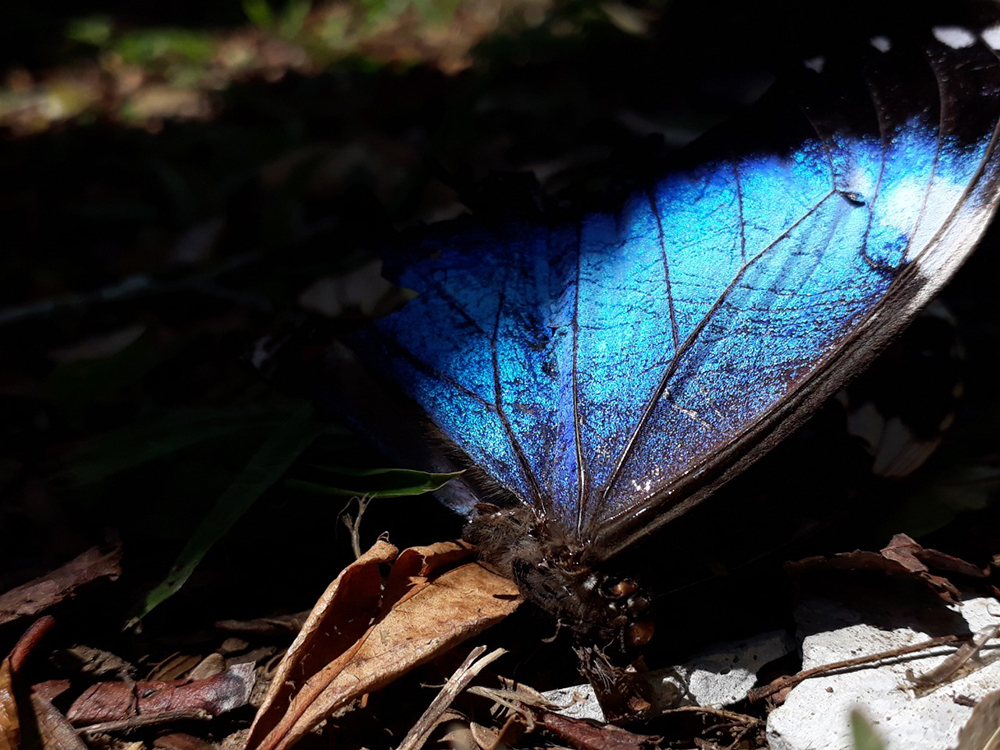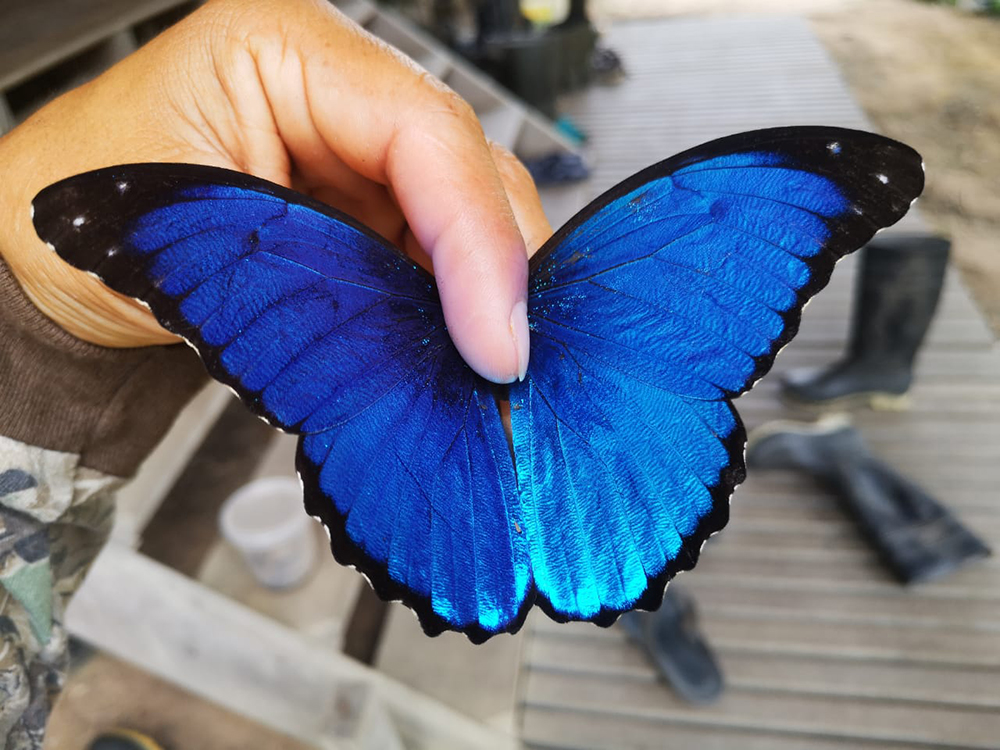
Arianna Ertl
Fall Semester Internship 2020
English Major at West Chester University minoring in Psychology and Italian.
Learn more about Arianna Ertl
August 30, 2021
THE BLUE MORPHO BUTTERFLY: An Amazonian icon
The Blue Morpho butterfly is an unforgettable sight for anyone who has been able to witness it flying through its natural habitat of the Amazon rainforest. The Blue Morpho certainly is a species that carries with it the true essence of the Amazon: beauty found in the heart of wildlife and a natural coexistence maintaining survival. That is one of several reasons why the ACEER Foundation selected the Blue Morpho butterfly to use as part of our logo.
With an aesthetic that delights the human eye, the Blue Morpho also has its role as a part of the ecosystem. The Amazon rainforest needs its native species like the Blue Morpho to keep the ecosystem thriving, but first these species need their home to do that. As deforestation continues, the native species of the Amazon are collectively experiencing the loss of their natural habitat. With an increase of deforestation there is a decrease in environmental sustainability and even the most beautiful creatures of the rainforest are no exception. Along with many other animal and insect species of the Amazon rainforest, the Blue Morpho butterfly is at risk of endangerment. The climate crisis we are facing is calling for an urgency to protect the rainforest and the native species that cannot replace their home. Protecting the Blue Morpho butterfly is important because of their unique qualities and the role they play in the ecosystem; this Amazonian icon is truly irreplaceable.
With an increase of deforestation there is a decrease in environmental sustainability and even the most beautiful creatures of the rainforest are no exception.
The Blue Morpho butterfly, also known as the Peleides Blue Morpho, needs a tropical climate to thrive. Residing in the rainforests of Latin America, reaching from Mexico, Columbia and even Costa Rica; these butterflies can be admired flying through the forest and along the water. Belonging to the Nymphalidae family the Blue Morpho is one of the largest butterflies in the world with a wingspan of five to eight inches. The name Blue Morpho stands for any of the blue butterflies in the genus morpho, “There are also numerous other Morpho species, which number 29 in total, including the brown, green and incredibly rare white butterflies” (Rainforest Cruises, 2016).

Luís Gustavo Arruda 

Jose Cueva
The male morphos are known for their beautiful blue color when in fact they are not blue at all. These butterflies are gifted with iridescent wings that give them a blue appearance, a result from, “a microstructure on their upper surface that refracts light, causing them to shimmer as the butterflies bask in the sun” (Christensen, 2002). In contrast, their underside is brown with eyespots used for camouflage from birds and insects. The name Morpho could be originated from the illusion they create of appearing and disappearing from alternating from blue to brown. Because the male morphos need to find a mate they are gifted with an aesthetic blue in contrast to the female butterflies, which tend to be less striking in color because they are not designed to impress the males. However, nature is full of loop-holes that can create a dual-gendered creature.

An interesting fact about these butterflies is that they are not always the typical male or female specimen. There are insects, primarily butterflies and moths such as the Blue Morpho, that are known as gynandromorphs, a specimen that contains both male and female cells. This case arrives in insects who have experienced a loss of a sex chromosome during cell division or when two sperm fertilize an egg that happens to have two nuclei inside of it (Bryce, 2015). This results in a combination of male and female cells, and for the Blue Morpho the effects are usually displayed on their wings. This process causes the Blue Morpho to have either bilateral wings in which one wing is male and the other is female, or the mosaic wing where the wings are both a mixture of the two. These gynandromorphs are a beautiful and unique part of the Blue Morpho family.
While the Blue Morpho is an aesthetically pleasing specimen, their appearance is only half of their importance. For the Blue Morpho, most of their time is spent reproducing and eating, with the adult butterflies drinking their food through a mouthpart called the proboscis. Acting almost as a natural maintenance system for the rainforest, they are known to be attracted to sweetness, sipping the juice of rotting fruit, the fluids of decomposing animals, tree sap, fungi and wet mud (Christensen, 2020).
The Blue Morpho’s keep to themselves usually staying on the forest floor hiding in the understory, with their wings folded for protection. However, when it is time to find a mate the Blue Morpho will search endlessly for their partner, “butterflies live for reproduction; they reproduce and die immediately after laying their eggs. Male butterflies release chemicals called pheromones in their wings and attract as many females as possible” (Shamsul, 2012). Even with the complexity of metamorphosis and reproduction, the Blue Morpho’s entire lifespan lasts only about 3 months (Haines, 2019). With a life span so short, it is even more of a calling to protect them and their tropical habitat.
With the irrevocable loss of the rainforest, Blue Morphos are severely threatened by deforestation of tropical forests and habitat fragmentation.
Rainforest Alliance, 2012
Although these butterflies were gifted with beauty, it also comes at a price. People from all over the world search for these butterflies to capture them for aesthetic purposes, such as putting them on display in galleries and using them for jewelry, “This butterfly is often featured in museums and zoos having butterfly houses or butterfly rainforests in the United States” (Ray, 2019). Along with being taken from their homes, these creatures, like many in the Amazon, are quickly losing their natural habitat and are at risk of endangerment. Originally, 6 million square miles of tropical rainforest existed worldwide. Today, as a result of deforestation, only 2.4 million square miles remain (Young, 2017). With the irrevocable loss of the rainforest, Blue Morphos are severely threatened by deforestation of tropical forests and habitat fragmentation (Rainforest Alliance, 2012). And when it comes to the ecosystem, everything comes full circle.
The ecosystem is an all-inclusive structure that uses every sum as the part of a whole. The rainforest needs the Blue Morpho butterfly because it has an ecological importance for the other Amazonian creatures that prey upon it (Amazon Aid foundation, 2020). Deforestation effects the food of these butterflies inevitably effecting the food of other animals, “aside from humans, birds like the jacamar and flycatcher are the adult butterfly’s natural predators (Weileman, 2020). The ecosystem works like the domino effect; the loss of even this small component to the ecosystem will directly affect its neighboring specimens and the natural maintenance of the rainforest. The neglect of such a beautiful and iconic creature is taking away one of the earth’s natural beauties as well as harming the diet and habitat of all Amazonian creatures.
It is imperative to protect the species of our planet such as the iconic Blue Morpho butterfly and their home, the Amazon rainforest. Follow ACEER’s Conservation Fellows to learn more about Blue Morpho butterflies and other species in need of our attention, wonder and protection.
Works Cited
Admin. “Blue Morpho Butterfly Facts, Information, Pictures & Video.” Active Wild, 16 Oct. 2019, www.activewild.com/blue-morpho-butterfly-facts/.
Barnes, Sara. “Photographer Captures Magical Sight of Brilliant Blue Butterflies Clustered on a Tree.” My Modern Met, 29 July 2020, mymodernmet.com/kelvin-hudson-blue-morpho-butterfly-picture/.
“Blue Morpho Butterfly.” Amazon Aid Foundation, 29 Aug. 2017, amazonaid.org/species/blue-morpho-butterfly/.
Bryce, Emma. “These Butterflies Aren’t Ordinary Males and Females.” The World from PRX, 2015, www.pri.org/stories/2015-08-13/these-butterflies-arent-ordinary-males-and-females.
Christensen, Lynne. “HOME OF: The Blue Morpho Butterfly.” The New York Times, The New York Times, 12 May 2002, www.nytimes.com/2002/05/12/magazine/home-of-the-blue-morpho-butterfly.html.
Haines, Drew. “15 Blue Morpho Butterfly Facts: Iridescent Gem of Ecuador’s Amazon (All 24 Species).” Gringos Abroad, 25 Nov. 2019, gringosabroad.com/blue-morpho-butterfly-facts/.
Ray, Haleigh. “Blue Morpho Butterfly Morpho Peleides Kollar (Lepidoptera: Nymphalidae).” EDIS New Publications RSS, Entomology and Nematology, 20 Feb. 2019, http://edis.ifas.ufl.edu/in1101ifas.ufl.edu/in1101.
Shamsul. “Blue Morpho Butterfly.” Costa Rica, 23 Apr. 2012, www.costaricajourneys.com/blue-morpho-butterfly/.
“Species Profile: Blue Morpho Butterfly.” Rainforest Alliance, 2012, www.rainforest-alliance.org/species/blue-butterfly.
Weileman, Steve. “Costa Rica: Blue Morpho.” Essex Media & Explorations, 7 Feb. 2020, www.xexplore.com/costa-rica-blue-morpho/.
Young, Allen M. “Butterflies and Plants: Designers of Tropical Rain Forest Pharmacology.” We Produce Programs and Publications That Explore, Explain, and Sustain Wisconsin Thought and Culture, 26 July 2017, www.wisconsinacademy.org/magazine/butterflies-and-plants-designers-tropical-rain-forest-pharmacology.
